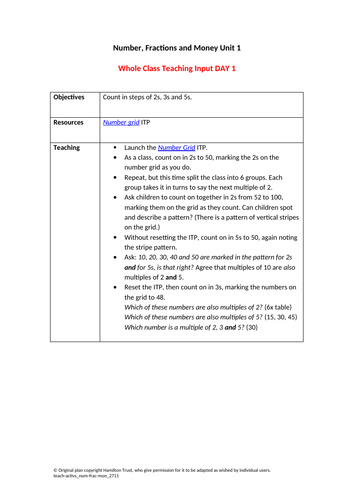




This presentation provides two days of teaching that cover the objectives:
- Count in steps of 2s, 3s and 5s.
- Count in 3s, making links to multiplication.
- Identify multiples of 3.
It includes starter activities, whole class teaching, group activities, practice sheets and mastery questions. It can be used on a variety of interactive whiteboards.
Day 1 Teaching
Count in 2s to 50, marking the 2s on Number Grid ITP. Mark 2s from 52 to 100 using the (stripes) pattern. Repeat to count in 5s; spot the pattern. Note multiples of 2 and 5 (10s). Count on in 3s, noting which numbers which are also multiples of 2 (6x table) and 5 (15, 30, 45). Which is a multiple of 2, 3 and 5? (30)
Day 2 Teaching
Use ITP Number Grid to highlight the count in 3s. We are counting on in 3s, adding 3 each time, so 3 + 3 is 6, 6 + 3 is 9, 9 + 3 is 12. These are multiples of 3. Note the pattern. Add the digits of each multiple of 3 in turn and show that these always add to 3 or 6 or 9 – our mathematical test to check if any number is a multiple of 3: finding the digit sum of the number. Try this for some big numbers, e.g. 123, 412, 339 and 450.
This teaching is part of Hamilton’s Year 2 Number, Fractions and Money block. Each Hamilton maths block contains a complete set of planning and resources to teach a term’s worth of objectives for one of the National Curriculum for England’s maths areas.
Something went wrong, please try again later.
This resource hasn't been reviewed yet
To ensure quality for our reviews, only customers who have downloaded this resource can review it
Report this resourceto let us know if it violates our terms and conditions.
Our customer service team will review your report and will be in touch.
